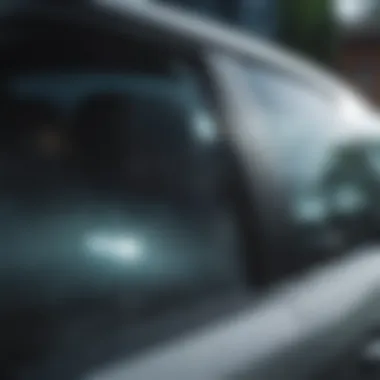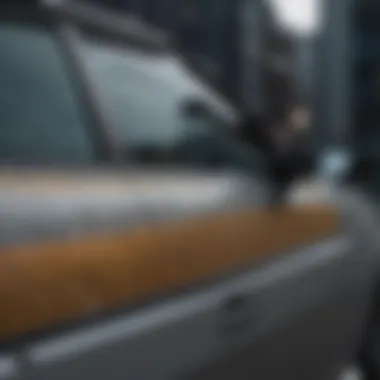Exploring the Best Window Film Solutions for UV Protection


Intro
The importance of window film for UV protection cannot be overstated. With the rise of awareness regarding the detrimental effects of ultraviolet rays, choosing the right window film has become essential. These films are not only a barrier against harmful UV radiation but also enhance comfort and preserve the interior aesthetics of homes and vehicles.
There are many options available for consumers, each offering distinct features and benefits. Understanding the nuances between these various types will help individuals make a more informed decision. This discussion will cover several areas of interest related to window films designed for UV protection, including effectiveness, application, and maintenance. In addition, practical advice will assist readers in determining which specific window film will best serve their needs.
As the article unfolds, experts’ insights and advancements in technology will be examined, guiding readers through the vital aspects of window film selection. Let us begin our exploration of this crucial topic.
Foreword to UV Protection
Protecting oneself from ultraviolet rays is an important aspect of maintaining health and wellness. Ultraviolet (UV) rays are present from the sun and can have significant long-term effects on skin and property. In understanding these impacts, selecting effective window films becomes crucial.
Understanding UV Rays
Understanding UV rays is essential for grasping why UV protection is necessary. There are three primary types of UV rays: UVA, UVB, and UVC. UVA rays penetrate deeply into the skin and are mainly associated with skin aging and wrinkles. UVB rays are responsible for sunburn and direct damage to DNA. UVC rays are largely absorbed by the Earth’s atmosphere and do not reach us. However, the implications of UVA and UVB exposure can lead to serious health issues.
Regular exposure to these rays can increase the risk of skin cancer and other ailments. The knowledge of how UV rays function is the first step in engaging with protective measures.
Consequences of UV Exposure
The consequences of UV exposure extend far beyond just the skin. Long-term effects can lead to serious health problems. Skin damage, such as sunburns, premature aging, and the development of skin cancers, are prominent concerns. Additionally, UV rays can also affect the eyes, leading to cataracts or other vision-related problems.
The impact on interiors should not be overlooked either. Faded upholstery or discoloration of furniture is a direct indication of UV damage.
Engaging with window films helps in the prevention of such consequences. Ultimately, understanding the dangers posed by UV exposure underscores the importance of effective film solutions on windows.
What is Window Film?
Window film can serve several fraudationate purposes, making it an essential element to consider in regard to UV protection. It acts as a barrier between interior spaces and outside UV rays, minimizing the adverse effects such rays have on skin and furnishings. Understanding the type and function of a given window film directly relates to its efficacy in mitigating sun damage.
Talented manufacturers have developed various window films tailored to specific needs. It is wise to evaluate these types properly to ensure optimum The first step in enhancing the quality of one’s environment involves assessing the available options based on distinct characteristics and heating needs among other relevant features.
Types of Window Films
Dyed Window Films
Dyed window films consist mainly of color pigments that offer a level of light reduction. Their key characteristic is the ability to block a substantial portion of UV rays while maintaining considerable visible light transmission. This trait makes dyed films a economical choice for many homes.
One unique feature of dyed window films relates to its simple composition which minimizes production costs. However, these films may not be the best choice for high-sun areas as they can fade over time. This fading could become an downside when comparing it with other more durable window film types, providing limited long-term efficacy.
Metalized Window Films
Metalized window films utilize a thin layer of metallic coating to reflect heat and UV rays. A key characteristic of these films lies in their heat-rejection capabilities, which can significantly lower indoor temperatures, making for a cooler environment. Such films often come highly recommended for climates where solar gain is inconvenient or excessive.
These films are prismed? to cause a bit of glare, and some materials might interfere slightly with cellular signals. Overall, its superior reflectivity however does tend to make metalized films a popular option for sharp energy savings.
Carbon Window Films


Carbon window films feature advanced resin technologies that enhance comfort without compromising aesthetics. A major advantage of using these films is that they are known for their non-reflective quality, ensuring clarity and comfort. Edmunds advantage comes from a unique feature that does not distort indoor views while blocking out harmful UV rays effectively.
Carbon window films indicate a growing trend where function meets visual appeal. They offer longevity compared to dyed films, and tend to surpass other hybrids in both resilience and appearance over cultured spaces.
Ceramic Window Films
Lastly, ceramic window films excel due to their chemical structure that combines durability and excellent UV Protection. Unlike other types, ceramics can effectively block heat yet maintain transparency, which assures clear views with minimal glare. A unique feature is their high level of scratch resistance while promoting thermal insulation.
Their smooth performance qualities may come at a slightly higher price point compared to dyed or metalized films; however, the long-term benefits typically offset given the advanced quality and lifespan they provide.
Characteristics of Effective Window Films
When considering window films for UV protection, it becomes imperative to assess several critical characteristics. An effective window film should maximally block UV light, not easily fade, and maintain clarity while reducing heat exposure. Resistance to abrasions and longevity should be reviewed, leading to a comprehensive understanding during purchasing decisions.
Optimally, customers should consider:
- The UV Blocking Percentage
- Visible Light Transmission
- The Type of Adhesive Used
These are fundamental aspects when deliberating window films. They offer critical clarity among various selections ensuring needs best align with options chosen.
Evaluating Window Films for UV Protection
Assessing window films for UV protection is crucial in selecting the right product. The importance lies in safeguarding both skin and interiors from harmful ultraviolet rays. Proper evaluation involves understanding specific films’ efficacy in blocking UV radiation. This understanding extends to studying the product specifications and broadening insights into individual needs. Each component influences not just safety, but comfort and aesthetics as well, making evaluation a multi-faceted process.
Factors to Consider
UV Blocking Percentage
The UV blocking percentage is a main factor in evaluating window films. A higher percentage equates to better protection against ultraviolet light. Many window films aim for a minimum of 99% UV blocking, emphasizing their effectiveness. Such a high blocking potential is beneficial, especially in areas with strong sunlight. However, extremely high UV blocking may reduce visible light, so a balance is important. Understanding this can help in choosing products that match environmental needs without sacrificing visibility.
Visible Light Transmission
Visible light transmission (VLT) measures how much light a window film lets through. While UV protection is necessary, a nuanced approach towards VLT is equally important. Films that allow considerable visible light often encourage a more open and spacious feeling inside. The key characteristic of VLT is the trade-off it presents between protection and brightness. Choosing a film with an appropriate VLT level enhances comfort and contributes to natural lighting during the day. Too low a VLT may induce reliance on artificial lighting, which contradicts environmental sustainability goals.
Type of Adhesive Used
The type of adhesive used in window films cannot be underestimated. It ensures the long-lasting nature of film applied during installation. A durable adhesive aids easy application and minimizes the chance of bubbling or failure over time. Industries tend to prefer pressure-sensitive adhesives due to their strength and immediate bonding. While these are favored, improper installation techniques can lead to faults. Therefore, knowing the adhesive type can guide consumers through product identity and relevance regarding durability and long-term benefits.
Top Rated Window Films
3M Window Films
3M window films are regarded highly for their advanced technology and effectiveness in UV protection. A key characteristic is their dual function in UV blocking and reducing heat. They are popular not only for optimal performance but also for scratch resistance. Nevertheless, the films may be on the pricier side—an investment worth considering for serious enthusiasts. They provide explanatory guides, making it easier for users to understand application and maintenance.
Huper Optik
Huper Optik is noted for its unique nanoceramic technology in window films. Its eco-friendliness adds value, making it suitable for environmentally-conscious users. Beyond UV protection, its impressive heat control capabilities contribute to overall comfort indoors. These films have demonstrated efficiency despite minimal visible light interference, creating a balanced indoor ambiance. The price, however, tends to be substantial, making careful evaluation essential for consumers.


SolarGard
The brand SolarGard offers a portfolio of various window films tailored for different needs. With strong UV blocking features, they are well-regarded in the industry. One unique attribute is the manufacturer's ability to customize films to fit various residential options. While nothing in window film is completely flawless, SolarGard emphasizes customer service and satisfaction. There is continuous positive feedback on their support mechanisms post-installation, further comforting buyers.
LLumar Films
LLumar Films excel largely due to their extensive research and specialty features. High optical clarity is a highlighted benefit of these films along with substantial UV rejection. A noteworthy quality is the aesthetic variety they offer, appealing to those looking for diverse interior styling. However, thorough comparison with alternatives is key before any purchase, avoiding regret or disappointment after investment. Many users find LLumar Films suitable for enhancing both protection and visual appeal.
Acting on knowledge about graded features enhances decision-making. By recognizing these differentiating factors, choosing the right window film becomes a tangible acquisition towards protective measures. Opting for informed preferences ultimately optimizes enjoyment while mitigating exposure risks.
Application Methods
The application methods for window film significantly influence its effectiveness and longevity. Selecting the right application approach can ensure optimal UV protection while enhancing the visual appeal of the application. Moreover, understanding the differences between professional installation and DIY methods can aid in making better decisions that suit individual needs and capabilities.
Professional Installation vs.
DIY
Deciding between professional installation and DIY can have major implications for the placement of window films.
Professional Installation
Engaging a professional assures expertise in alignment and precision. Professionals use quality tools designed specifically for window film application. This drives towards a flawless finish, minimizing air bubbles or misalignment, which can affect both aesthetics and performance.
DIY Installation
Conversely, DIY tasks often entice those looking to save money. There are many kits available in hardware stores, providing all needed materials. Careful attention can yield adequate results; however, the skill level plays a big role. Mistakes during self-installation can lead not only to visible defects but also compromise the film's protective qualities.
Ultimately, the right choice often boils down to personal comfort, skill, and the budget at hand.
Preparation Steps for Installation
Proper preparation is crucial before applying window films. Here are some essential steps to follow:
- Research - Understand the different types of films and their benefits and select one that meets specific needs.
- Gathering Supplies - Procuring a clean cloth, spray bottle with a soapy solution, squeegee, and a utility knife for the installation is required.
- Measuring Windows - Accurate measurements of the glass ensure the film fits correctly, avoiding unnecessary wastage or misapplication.
- Cleaning the Surface - Clean the windows thoroughly to remove dust, dirt, and grease. Any residue can show once the film is installed and eventually affect performance.
- Cutting the Film - Cut a piece of film that is slightly larger than the glass dimension. It is vital to allow some excess that can be trimmed later.
- Application - Mist the glass surface with a soapy solution, peel off the film backing, and smoothly lay it onto the glass. Use a squeegee to remove air bubbles and excess moisture beneath.
- Trimming Edges - Once applied, trimming excess film can create a clean finish, allowing the full adherence of the film to the glass.
Preparation should not be overlooked. It sets the tone for everything that follows and ensures a proper and successful installation.
Beyond UV Protection
While UV protection is crucial, it is only part of the overall benefit that window films provide. Understanding the capabilities of window films beyond UV protection is essential for homeowners and car enthusiasts alike. Effective window films do much more than block harmful ultraviolet rays; they enhance comfort, privacy, and even energy efficiency in relevant applications.
Heat Rejection Capabilities
Heat rejection is one vital benefit that many window films offer. This feature becomes particularly helpful in regions with intense sunlight. By reflecting and absorbing heat, window films create a more comfortable indoor environment.
- Enhanced Comfort: Films designed for heat rejection can significantly lower the temperature inside a car or building. This is especially valuable during the peak summer months when indoors can become uncomfortable hot.
- Energy Efficiency: Reducing the heat entering through windows can lessen the reliance on air conditioning systems. This results in lower energy bills and reduced strain on air conditioning units.
- Temperature Regulation: Effective films help in maintaining a steady indoor temperature. This can prevent hot spots near windows where the sun directly hits, promoting a more uniform and pleasant indoor climate.


Privacy Enhancement
Privacy is a primary concern for many people when selecting window films. Different types of window films come with varying degrees of privacy control. Consider the following aspects:
- One-Way Privacy: Certain films allow for an unobstructed view from the inside while blocking visibility from the outside during the day.
- Frosted Films: Frosted window films obscure vision in both directions. This style is popular for bathrooms or office buildings where confidentiality is paramount.
- Room Appearance: Privacy films can also add a layer of sophistication to a space. Many designs not only serve privacy purposes but can also improve aesthetics. This includes films with patterns and colors that complement a room's decor.
Ultimately, understanding these factors contributes to the wise decisions homeowners and car owners can make. It is not only about blocking harmful rays. Heat rejection and privacy enhancement are equally significant details one must consider.
Maintenance of Window Films
Maintaining window films effectively is crucial for allowing them to provide optimal protection against UV rays and other elements. Proper maintenance assures durability and enhances visibility while preserving the film's aesthetic value. Over time, dirt, dust, and residues can diminish the clarity and effectiveness of the window film. Therefore, fostering healthy practices for maintenance enables users to safeguard both personal health and the condition of interior spaces.
Regular upkeep of window films serves several important benefits:
- Prolongs Lifespan: Regular cleaning and maintenance can significantly extend the lifespan of the film. With fewer contaminants staining the surface, the film materials remain intact.
- Maximizes Performance: Clean films can perform better in terms of blocking UV light and reducing heat.
- Aesthetical Appeal: Clean and well-maintained films enhance the overall appearance of windows.
It should also be noted that common actions can damage the film, such as using abrasive materials or certain chemicals. Choosing the right cleaning methods is vital to ensure that the film remains effective and appealing.
Cleaning Techniques
When it comes to learning proper techniques for cleaning window films, simplicity and care are key. It is advisable to follow the manufacturer's guidelines; however, general best practices usually apply:
- Use Soft Cloths: A microfiber cloth is recommended to clean the film without scratching the surface.
- Gentle Cleaning Solutions: Mild dish soap diluted in water is effective for removing dirt and grime. Avoid using ammonia-based cleaners or solvents, as they can warp or tarnish the film.
- Regular Schedule: Establishing a regular cleaning schedule, such as monthly, can drastically reduce the build-up of dirt and residue.
- Rinse and Dry: After cleaning, make sure to rinse the surface with water and dry it with a fresh cloth to prevent streaks.
By adopting these cleaning approaches, the window films can maintain both clarity and protective qualities without significant damage.
Identifying Damages and Repairs
Addressing potential damages in window films early prevents further issues later on. Observing the film regularly will help identify problems that may impact performance or visuals. Here are a few signs to look for in assessing the health of the films:
- Bubbles or Peeling: These are signs of improper installation or wear. The presence of bubbles may also signify water leakage underneath.
- Scratches: A noticeable scratch can compromise both the aesthetic and functionality of the film.
- Discoloration: A fading film not only aerosolizes UV blocking but detracts from the visual experience.
Understanding whether damage is significant enough for complete replacement or if it can be repaired is also crucial. Cuts or small abrasions could be potential candidates for repair patches.
In summary, proactive measures in cleaning and regularly checking for damages help ensure optimum performance from window films. For reliable linger-term benefits, continuous attention to the film's condition environment is essential.
Finale
Understanding window films for UV protection is crucial as they serve both functional and aesthetic purposes. People increasingly recognize the value of safeguarding their health and belongings from harmful ultraviolet rays. This consideration is paramount not just for personal well-being, but also for the longevity of upholstery, artwork, and other interior elements.
By summarizing the key points discussed in this article, the crucial roles of various window films become clear. These films vary in types, like dyed, metalized, carbon, and ceramic. Each offers distinct benefits in UV filtering, yet the specific needs of your environment require careful evaluation. Moreover, the effectiveness of a film often depends on integral factors such as UV blocking percentage and visible light transmission. Understanding these elements improves decision-making dramatically.
Installing window film has evident and practical benefits, safeguarding homes from UV radiation while contributing to energy efficiency and comfort.
Summary of Key Points
- Importance of UV Protection: The harmful nature of UV rays makes protection essential. Films can reduce exposure significantly.
- Types of Window Film: From dyed to ceramic options, each type provides different advantages suitable for various needs.
- Critical Factors in Selection: Visibility levels, application quality, and how decisively films block UV rays play large roles in effectiveness.
- Beyond Protection: Films frequently offer benefits like heat rejection, glare reduction, and privacy enhancement, making them versatile solutions.
Making the Right Choice
Choosing the right window film requires more than just selecting the darkist shade available. Here are some factors to consider when making a decision:
- Assess Your Needs: Identify the primary purpose; whether it is UV protection, reducing glare, or maintaining privacy.
- Evaluate the product reviews: Research existing products, such as 3M Window Films, Huper Optik, SolarGard, and LLumar Films, from credible sources.
- Seek Professional Advice: Consulting specialists can reveal critical facet of your environmental needs and best solutions.
- Understand Installation Types: Decide if you will opt for professional installation or if a DIY approach is feasible for your situation, weighing its impact on overall film perfomance.
- Long-Term Considerations: Look at maintenance requirements and warranties. Lifespan and warranty terms can influence your decision on different films.
By paying close attention to these considerations, you arm light well informe keuze for both your health and investments.















